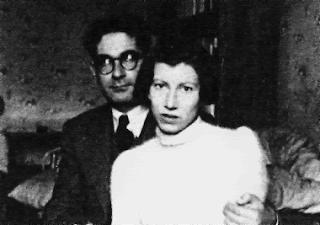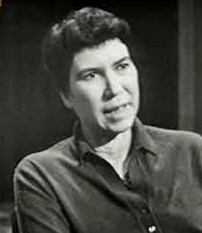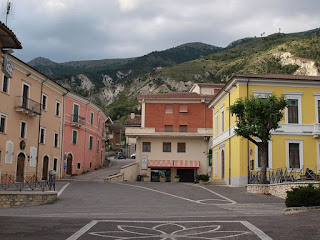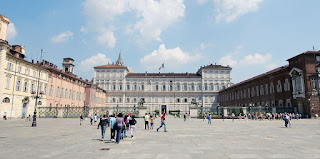Sicilian raised in Turin became one of Italy’s great postwar novelists
 |
| Natalia Ginzburg (née Levi) with her husband, the leading anti-Fascist figure, Leone Ginzburg |
The author of 11 novels and short story collections, as well as numerous essays, Ginzburg came to be regarded as one of Italy’s great postwar writers, alongside Primo Levi, Carlo Levi, Alberto Moravia, Cesare Pavese, Elsa Morante and Giorgio Bassani among others.
Her most famous works include Tutti i nostri ieri - All Our Yesterdays - published in 1952, Lessico famigliare - Family Sayings - published in 1963, and La famiglia Manzoni - The Manzoni Family - published in 1983.
She was notable for writing about family relationships, politics during and after the Fascist years and World War II, and philosophy.
Ginzburg, who was married to a prominent figure in the Italian resistance movement in World War Two, was an active anti-Fascist and a member of the Italian Communist Party in the 1930s. In later life, she was elected to the Chamber of Deputies as an independent.
 |
| Ginzburg became a leading light in postwar Italian literature |
The family was well connected in social and intellectual circles in Turin. Her sister, Paola, married a future president of the business machines company, Olivetti, of which one of her brothers, Gino, became Olivetti’s technical director. Of her two other brothers, Mario was a journalist and Alberto a doctor.
As a Jewish family - although her mother, Lidia, was a gentile - they were heavily involved in the city’s anti-Fascist movement and suffered for it. Natalia’s brothers were frequently arrested and sometimes jailed for their activities. Guiseppe Levi was in time stripped of his position at the university and moved to Belgium.
Natalia’s brothers were members of the anti-Fascist organization Giustizia e Libertà (Justice and Liberty), the leader of which was Leone Ginzburg, a professor of Russian Literature at the University of Turin, with whom she began a relationship.
Like her father, Leone was dismissed from his university position. He was under constant surveillance from Mussolini’s secret police and eventually stopped visiting the Levi family home, worried that he was putting the family in danger. Nonetheless, he and Natalia continued to see one another and were married in 1938. They had three children, the eldest of whom, Carlo Ginzburg, is now an eminent historian.
 |
| A recent edition of one of Ginzburg's most acclaimed works, Family Lexicon |
Mussolini was deposed but it did not mean the Ginzburgs could rest easy. When Nazi Germany invaded the peninsula, Natalia was determined to be reunited with her husband and managed to persuade a German army unit to take her to Rome, claiming she and her children were refugees who had lost their papers.
They found Leone and went into hiding but it was not long before he was arrested. This time their separation was permanent. By the following February, Leone had died aged 34 after suffering a cardiac arrest in the Rome prison of Regina Coeli, having been subjected to brutal interrogation and torture.
At this time, Natalia Ginzburg’s career as a writer was in its infancy, although she was already the author of a novel published under a pseudonym in 1942 at a time when Mussolini’s race laws barred Jewish authors from seeing their work in print.
After the war, she worked at the Turin publishing house of Giulio Einaudi - of which Leone had been a founder - and became acquainted with some of the leading figures of postwar Italian literature, including Carlo Levi, Primo Levi, Pavese and Italo Calvino. It was Pavese who is said to have given her the most encouragement to write more herself.
Her own output increased after she was married for a second time, in 1950, to Gabriele Baldini, an academic. They lived in Rome and for many years were at the centre of the city’s cultural life, Ginzburg’s novels, short stories, essays and plays attracting much critical acclaim. Having become friends with the director and writer Pier Paolo Pasolini, she even accepted a small part in his 1964 film, The Gospel According to St Matthew, in which he followed the neorealist tradition of using non-professional actors.
Ginzburg won some of Italy’s most prestigious literary awards, including the Strega Prize for Lessico famigliare and the Bagutta Prize for La famiglia Manzoni.
She and Baldini had two children, although both were born with severe disabilities and the first died after only a year. Baldini himself died young, in 1969 at the age of only 49.
Ginzburg was never far from active politics. Like so many anti-Fascists from the wartime period, she was at times a member of the Italian Communist Party, although when she was elected to the Chamber of Deputies in 1983 it was as an independent.
Her literary output began to slow down in the 1980s. She died in Rome in 1991 at the age of 75.
 |
| Piazza San Carlo in Turin, looking towards the churches of Santa Cristina and San Carlo |
The original offices of the Einaudi publishing company in Turin were in Via dell'Arcivescovado, a few steps from the beautiful Piazza San Carlo, one of the city's main squares. A stunning example of 16th and 17th century Baroque design, the large piazza is notable for the twin churches of Santa Cristina and San Carlo at the southwest entrance to the square and for the monument to Emanuele Filiberto, a 16th century Duke of Savoy, in the centre. Spectacularly lit up in the evening, the square is home to two of Turin's most famous coffee houses, the Café San Carlo and Café Torino, as well as the Confetteria Stratta, renowned for the exquisite pastries it offers.
 |
| Piazza Municipio is the main square of the Abruzzo village of Pizzoli |
Pizzoli was an impoverished village in is a remote, mountainous part of central Italy some 135km (84 miles) northeast of Rome at the time the Ginzburg family were exiled there in 1941. Nowadays it is a well-kept, lively small town popular with visitors to the area as a starting point for trekking holidays in the mountains of the Gran Sasso e Monti della Laga National Park. Situated 15km (9 miles) northwest of the city of L'Aquila, Pizzoli is typical of the region in that it has the feel of a different time when life was less frantic. Its local quisine features pork and mutton in abundance, with thin skewers of salted, flame-grilled mutton called Arrosticini among its specialities.
Also on this day:
1602: The birth of Cardinal Jules Mazarin, ruler of France
1902: The collapse of the bell tower of St Mark’s Basilica in Venice
1948: The shooting in Rome of Italian Communist Party leader Palmiro Togliatti



